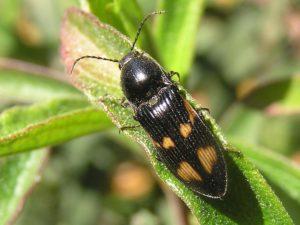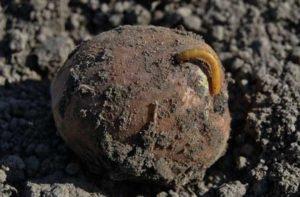Click Beetle and Wireworm: 17 Effective Pest Controls
Gardeners, when collecting root crops, noticed that they came across tubers damaged by worms that looked like pieces of wire. These are the larvae of the click beetle. This species is distributed almost throughout the globe, and its representatives cause great harm to plants.
Content
Click beetle and its larva wireworm: photo
Description of the beetle
Its name beetle received, thanks to the unique ability to roll over from the back to the abdomen with the help of a jumping mechanism. At the same time, a clicking sound is heard.
The body of the nutcracker is oblong, 10 to 60 mm long, black or brown. Nutcrackers living in the tropics have a more varied coloration. Their body is:
- yellow;
- orange;
- red;
- green with a metallic sheen or silvery hairs.
Some species may have stripes or spots on the elytra.
Nutcracker species with bioluminescent glow live in Central America.
Two light organs are located at the corners of the pronotum and one in the middle of the first abdominal sternite, and they are visible in flight. Females thus attract partners. Also, some wireworms that have bioluminescence, they use it to attract food.
Characteristics of the larva

Wireworm larva.
Due to the decrease in the number of soil treatments and the reduction in crop rotation, the number of wireworm pests has increased. The larva of the click beetle, or wireworm, has a body consisting of 13 segments, cylindrical, with a dense chitinous cover, naked, in rare cases covered with hairs.
The body color of the wireworm varies from light yellow to dark brown. Its length is up to 30 mm. The pupa is white, beige or yellowish. The larva eats the seeds, and as it matures, the root system of seedlings.
Distribution
There are about 10000 species of click beetles in the world. They live all over the planet, only in Antarctica they do not survive. In the tropics, these insects are larger and more diverse in color.
Reproduction and nutrition
As soon as warm days come in spring, female nutcrackers fly out and start laying eggs. Their favorite nesting sites are wheatgrass, burdock, weed roots and stalks. If suitable vegetation is not available, they may lay their eggs in cracks in the ground or under soil clods. They especially love the land where root crops are planted.
The life cycle from an egg to an adult beetle lasts 4-5 years. The female lays an average of 120-150 eggs. They are white and small. In one clutch from 5 to 15 eggs.
The larvae appear in a month, they grow and develop for several years. In the first year of life, the nutcracker larva feeds mainly on plant roots and weed leaves. But in the second year, wireworms settle in potato tubers, carrots, beets, and radishes. They eat seeds and sprouts of cereals. And only after four years they pupate and adult beetles appear on the surface in spring.
Beetles feed on leaves, but there are carnivorous species of click beetles. Adult beetles of some species do not feed at all, they live off the reserves that they have accumulated while in the larval stage.
Why beetle "clicker"
The jump mechanism is a small thoracic process. It is arranged between the prothorax and the mesothorax, if the beetle falls on the back, then it works, and turns it in the air back onto the abdomen, while a click is heard. From any position, the nutcracker rolls over onto its paws.
Also, when rejecting a beetle, when leaving the pupa, or avoiding danger, the beetle uses its jumping mechanism.
Signs of the appearance of wireworm on potatoes
In addition to tubers, larvae can eat roots and tops. The appearance of a pest can be judged by:
- wilted potato bushes. Pests move in the soil at a depth of 1 to 2 m. They can move no more than 20 cm from the tubers;
- the presence in young tubers of through narrow holes and dark depressions on the peel - they are places of movement of the larvae. Early digging potatoes will help detect the pest;
- movement of parasites in the upper soil layer (at the level of 5-10 cm). This usually happens when loosening or digging.
Harm and methods of struggle
Larvae cause particular harm, and control methods are aimed at their destruction. Wireworms make holes in the roots and root crops. They spoil the seeds and thin out the seedlings.
Even one beetle can be the cause of a large colony.
Planting plants
Properly organized crop rotation will significantly reduce the number of wireworms on the site. The same applies to the neighbors, that they will scare away the pest with their smell. Planted:
- Dahlias. The pest does not tolerate the smell of the plant.
- siderates. Mustard, rapeseed, buckwheat and sweet clover secrete essential oils into the soil, which repel click beetles and wireworms.
- legumes. These crops, especially peas and beans, repel insects.
Efficient cleaning
Keeping the site clean is the key to preserving the integrity of the entire crop. With the threat of a wireworm, it is necessary to pay special attention to some points.
Engaging Allies
The natural enemies of wireworms will help reduce the population and even completely destroy them. One of these is the garden ground beetle - the larva of which is similar to the larva of the wireworm. Also help birds:
- wagtails;
- starlings;
- turtledoves;
- rooks;
- thrushes;
- woodpeckers.
Folk methods
| Eggshell | One of the cheapest and most versatile tools. It is crushed and processed tubers before planting. Usually, eggshells are placed in the hole or scattered over the beds. |
| nettle or dandelion | 0,2 kg of dandelion or 0,5 kg of nettle is added to a bucket of water. The resulting mixture is treated with each well before planting. Such processing begins 7 days before planting with an interval of every 2 days. |
| Ammonium nitrate | Ammonia repels pests, forcing them to go deep into the soil. Enough 20-30 grams for 1 square. meters. |
| potassium permanganate | 3 g is diluted in a bucket of water and the holes are poured before planting. Processing adult bushes with this solution will also benefit. |
A proven and safe folk method is mustard. Rules for its use - Article.
Traps
Traps will help to collect more wireworm larvae in one place and destroy them. There are several effective baits.
- Potato. The tuber, which can be spoiled, is soaked in water for a day, then buried in the ground. There are several such traps. After 2 days, you can dig out and destroy the tubers, they will be completely riddled with larvae.
- Pieces of potatoes or carrots in the bank. It is necessary to put a few pieces and dig the container up to the throat, and cover the top with cardboard. In a few days, most of the site's wireworms will gather there.
- Cereals. Two weeks before work on the main planting, it is necessary to sow several holes in the area with barley and wheat. Young sprouts will lure hungry pests. They are dug up and burned.
Chemicals
Potato treatments with various chemicals are effective. But their use must be controlled. Early varieties cannot be treated with chemistry, they accumulate substances and do not have time to remove them. For the rest, the following are suitable:
- Prestige;
- Cruiser;
- Commander;
- Taboo.
Detailed instructions for processing potatoes from wireworms - here to register:.
Conclusion
Nut beetle larvae damage tubers, root crops and cereal crops. Control methods are available and their regular application will help protect the grown crop from this pest.
Previous


